Some of the links in this post are affiliate links. This means if you click on the link and purchase the item, we will receive an affiliate commission from the vendor at no extra cost to you. These business relationships allow us to keep bringing you great EatMoveHack content. All opinions remain our own.
There are tons of benefits to a great cardio workout. You’ll burn calories and lose weight, tone your muscles to give yourself a sleeker appearance, and feel better thanks to the reduction of stress and release of endorphins. But one of the biggest benefits of cardio exercises is that it improves your cardiovascular (or circulatory) system. This includes your heart, major arteries, and veins.
As your circulatory system is responsible for transporting oxygen throughout your body to keep you alive, it’s important that you take care of it if you want to live a longer, healthier life.
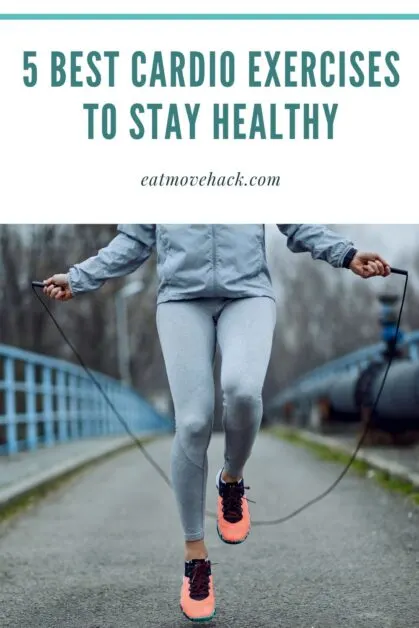
The Best Cardio Workout Routines
To offer the greatest benefits, your cardio exercises really have to get your heart pumping. The following are some of the best cardio workout moves that you can incorporate into your fitness routine. They’re the best because they’re suitable for all skill levels, you can do most of them just about anywhere, and most don’t require any equipment.
1. Jumping Rope
The humble jump rope may seem like an extremely basic piece of exercise equipment, but it can help you tone and strengthen muscle, increase flexibility, and get your heart rate up. Best of all, a jump rope can be ridiculously affordable and store easily in a purse, briefcase, or backpack for use at a moment’s notice.
When you’re jumping rope, you offer your arms, legs, and abdomen an effective but low-impact workout. If you haven’t been doing cardio exercise for a while, you may notice that you tire easily. That’s okay — go at a pace that’s comfortable to you, and take breaks as needed. The more time you put into jumping rope — or any exercise, really — the more endurance you’ll build.
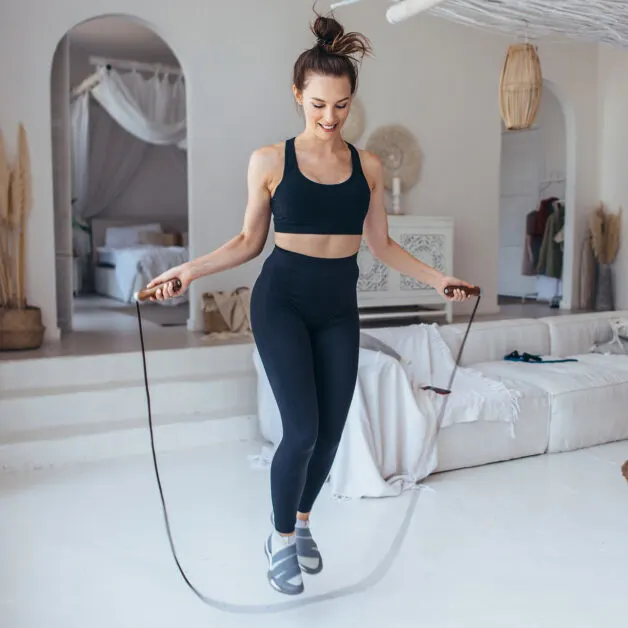
How to jump rope
- Grasp the handles of the jump rope, one in each hand.
- Bring your hands to hip height, but keep your shoulders relaxed.
- Bring your elbows closer to your torso, while pushing your hands outward.
- Slightly bend your knees to prepare for your first jump, and tighten your abdomen.
- Rotate only your wrists to bring the rope into motion. As the jump rope approaches your feet, hop over it. Jump only as high as necessary to clear the rope so as not to put unnecessary pressure on your joints.
- Continue rotating your wrists to pass the jump rope over your head and under your feet in a smooth, continuous movement.
- Continue jumping rope for at least 15 minutes.
If you find traditional jump roping boring or not challenging enough, you can jump feet first into these variations.
- Jump using just your left foot. After 20 reps, or when your left leg tires, switch to your right foot for an equal number of reps, and then switch again when your right leg tires.
- Use your alternate foot for each jump. Start with your left foot for the first jump, and then switch to your right foot for the second. Switch back to the left leg for the third jump, the right leg for the fourth jump, and so forth.
- Try jumping with high knees to really give your calves and thighs a workout. With each jump, soar into the air, bringing your knees high.
2. Jumping Jacks
Jumping jacks are another type of basic cardio exercise that gets your whole body moving. It’s an effective way to work out your heart, lungs, and major muscle groups without too much straining.
Best of all, you can control the intensity of your cardio workout by altering the speed at which you move. If you’re a beginner, don’t push yourself too hard; you’ll start moving faster soon enough.
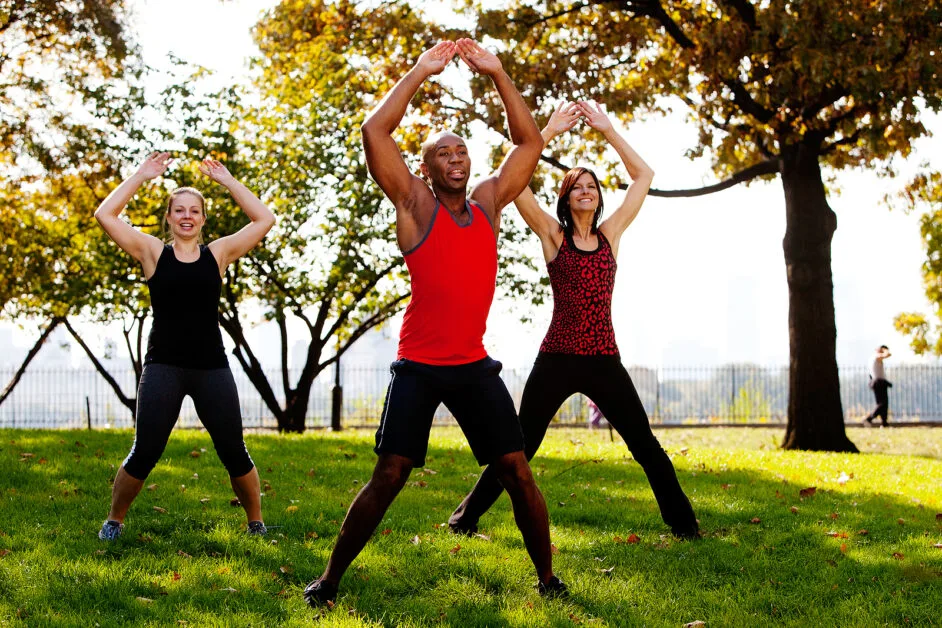
How to do jumping jacks
- Stand upright with your feet together and your arms at your sides.
- Jump slightly, spreading your legs outwards beyond hip-width and raising your arms above your head. You don’t bend your knees, but you will slightly bend your elbows.
- Jump again, bringing your feet back together and your arms to your sides to return to your original stance. You’ve completed one rep of jumping jacks.
- Beginners should aim to complete at least 10 jumping jacks. As you build endurance, continue the cardio workout for about 20 minutes.
3. Squat Jumps
As you gain endurance and increase your flexibility, you can turn to more difficult cardio exercises to challenge your body further. An intermediate exercise that concentrates on the abdomen and lower body is squat jumps.
You may already with the squat position, where you lower your body by bending your knees and then stand upright. Squat jumps takes things an extra step further to increase your engagement.
How to do squat jumps
- Stand upright with legs spread wide.
- Bend your knees to lower your body towards the ground. Keeping your back straight, continue bending your knees until your butt is slightly lower than your knees.
- While completing the crouch, extend your arms in front of you to help with balance.
- Once you’ve reached the bottom of your crouch, propel yourself upwards in a jump, extending your arms behind you to help with upward momentum.
- When your feet touch the ground, immediately bend your knees to return to the squat position, starting the next rep.
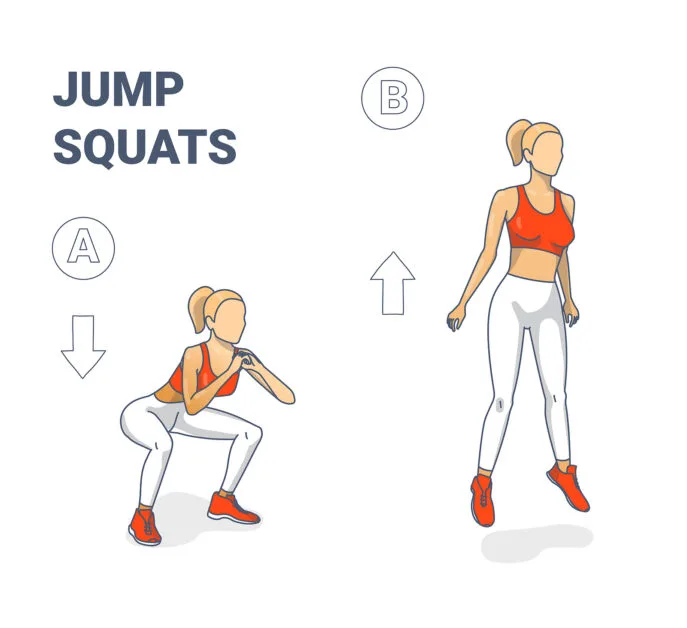
4. Planks
Holding the plank position definitely looks easy, but once you start, you’ll quickly notice that it takes quite a bit of strength, balance, and endurance to maintain the pose. The longer you hold the position, the faster you’ll notice your heart pumping.
How to do planks
- To get into the plank position, you’ll first get on your hands and knees.
- Place your hands flat on the ground, and straighten your arms to support your upper body. Make sure your arms are directly under your shoulders.
- Extend your legs backward until they’re straight, with feet shoulder-width apart, and then raise up onto your toes.
- Keep your neck, back, hips, and legs in a straight line. Do not extend your arms farther in front of you, raise your hips, or drop your back to reduce the intensity of the exercise; doing so may lead to injury.
- Maintain the position for as long as you can. Beginners should try for at least 30 seconds, while those looking for a killer cardio workout should try to hold the position for as long as possible.
Planks can be a serious cardio workout, but if you find the high plank position too difficult to hold, you can try some variations until you build more strength.
- Rather than straighten your arms to raise your upper body, lower yourself to your forearms. This will put less strain on your arms and allow you to hold the position longer.
- If you find that the exercise is still too difficult, you can also take the pressure off your lower body by dropping to your knees.
- No matter which variation you try, be sure to maintain a straight line throughout your body to keep your abdomen and other muscles engaged.
5. High-Intensity Interval Training (HIIT)
HIIT is not a single exercise, but rather a series of cardio exercises performed at a very high intensity for a short period of time to get your heart rate up in a hurry. Researchers have found that HIIT offers many of the same benefits as longer exercise routines — like weight loss, improved cardiovascular health, and increased endurance — but in a much shorter amount of time.
Another huge benefit of HIIT is that it allows you to develop your own cardio workout. You can incorporate the exercises that you like most, either because they’re not too challenging or just the opposite. And because you’re completing the cardio exercises in short, intense blocks, there’s not enough time to get bored.
How to perform HIIT
- Choose a cardio exercise, like pushups, jump roping, or planks.
- Perform your chosen exercise as quickly as you can for 20 seconds. The idea is to work out at the highest intensity possible for the duration of the rep.
- At the end of 20 seconds, stop your exercise, and rest for 40 seconds.
- At the end of your 40-second break, restart the same exercise or choose another.
- Repeat the 20-second reps followed by 40-second breaks for up to 20 minutes.
Because HIIT reps are performed at such a high intensity, you can choose almost any cardio exercises you’d like for your routine. Some popular choices include:
- Crunches
- Jumping jacks
- Planks
- Push-ups
- Sit-ups
- Sprints
- Squats
To prevent injuries and strain to your body, be sure to warm up for at least 10 minutes before starting your HIIT workout.
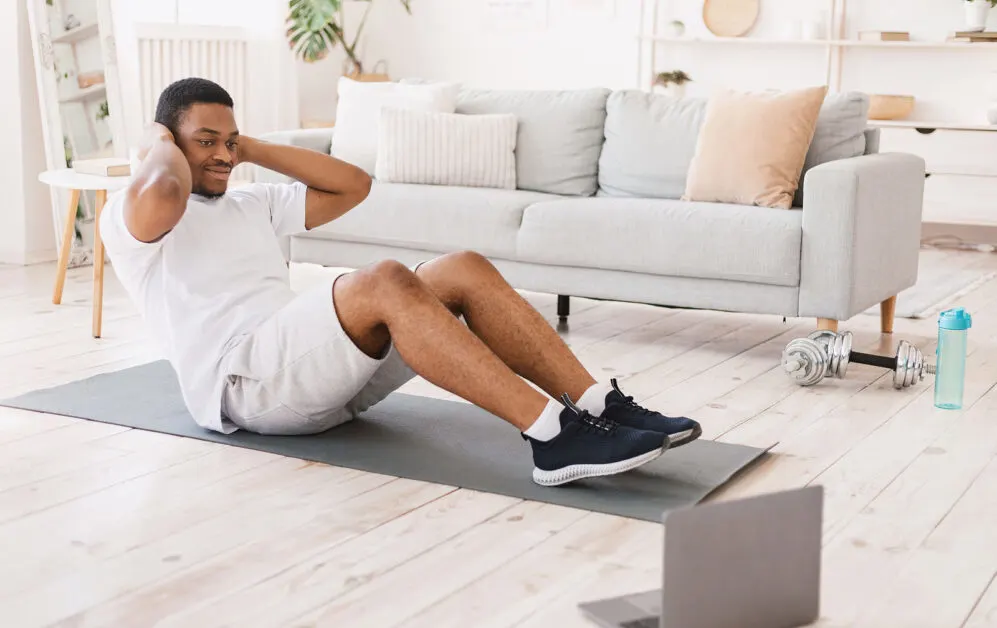
Tips for Staying Active
When you get busy with work, taking care of children, keeping up the house, and maintaining a social life, you may find it difficult to fit a great cardio workout into your schedule.
Many people believe that in order for exercise to matter, it has to be done in one session. But as HIIT has shown us, even short bursts of exercise can be extremely beneficial.
If you struggle to fit exercise into your daily schedule, follow these tips to sneak in exercise throughout the day.
- Park farther away from grocery stores, restaurants, and other places that you visit. Parking at the back of the lot will allow you to get in a small amount of walking.
- Get off the couch during commercial breaks when you’re watching TV. Use the three to four-minute interruptions to jog in place, do push-ups, drop to the plank position, or engage in some other cardio exercise to get your blood pumping.
- Move faster when completing household chores. Treat vacuuming, doing laundry, and washing dishes as if they’re part of a competition. The faster you move, the harder your heart will pump.
- Get a fitness tracker to help with motivation. When you can see how many steps you walked or how active you were, you have a baseline so you can do better the next day.
- Use music to keep from getting bored. Whether you’re cooking, folding laundry, watching a baseball game, or watching the kids, turning on some music will encourage you to move. You don’t have to go all out with dancing, but even swaying your hips or moving your arms will help you burn a few more calories.
Wrapping Up
If you want to improve your cardiovascular system and do right by your heart, you have to give it the exercise it needs to stay strong and healthy. The best cardio exercises are obviously those that get your blood pumping. But they’re only effective if you actually do them. The workout ideas we’ve outlined above are simple enough for anyone to try, no matter your age, fitness level, or schedule. Start slow, and it won’t be long before you find yourself pushing yourself harder and harder.
Want to get your exercise routine down pat? We can help you build a workout plan in just 10 minutes.

